 A 90-year-old piece of cake from the wedding of Cornelia Stuyvesant Vanderbilt to John Francis Amherst Cecil on April 29, 1924, has been rediscovered and donated to the Biltmore House collection. The small sliver of fruitcake, that most enduring of cake varietals, was found by Frederick Cochran when he was going through a trunk he inherited from his aunt Bonnie Revis, formerly a cook at Biltmore House. It was in a tiny beige box stamped “Biltmore House” on the lid.
A 90-year-old piece of cake from the wedding of Cornelia Stuyvesant Vanderbilt to John Francis Amherst Cecil on April 29, 1924, has been rediscovered and donated to the Biltmore House collection. The small sliver of fruitcake, that most enduring of cake varietals, was found by Frederick Cochran when he was going through a trunk he inherited from his aunt Bonnie Revis, formerly a cook at Biltmore House. It was in a tiny beige box stamped “Biltmore House” on the lid.
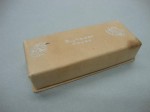 Cochran looked inside and saw what he thought was a piece of cheese (fruitcake looks cheesy after a century, it seems). He called Biltmore House and reported his find. Biltmore Museum Services collections manager Laura Overbey went to Cochran’s home to examine the artifact and bring it back to the great estate in Asheville, North Carolina. She recognized the box from the two distinctive monograms on either side of the “Biltmore House” on the lid as those of Cornelia Vanderbilt and John F. A. Cecil, which marked the box and its contents as originating at their huge society wedding.
Cochran looked inside and saw what he thought was a piece of cheese (fruitcake looks cheesy after a century, it seems). He called Biltmore House and reported his find. Biltmore Museum Services collections manager Laura Overbey went to Cochran’s home to examine the artifact and bring it back to the great estate in Asheville, North Carolina. She recognized the box from the two distinctive monograms on either side of the “Biltmore House” on the lid as those of Cornelia Vanderbilt and John F. A. Cecil, which marked the box and its contents as originating at their huge society wedding.
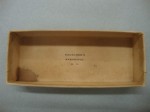 As far as she knew, however, there was no cheese gifting at the Vanderbilt-Cecil wedding. It wasn’t until she overheard a couple of conversations that she was able to put the pieces together.
As far as she knew, however, there was no cheese gifting at the Vanderbilt-Cecil wedding. It wasn’t until she overheard a couple of conversations that she was able to put the pieces together.
Back at Biltmore, one of Overbey’s coworkers happened to be talking about “how a friend had found a piece of Grover Cleveland’s wedding cake” — and she realized what she likely had in the pretty little box. Even more coincidental, as she walked into the office of her director, Ellen Rickman, to tell her the news, she heard an oral history to which Rickman was listening, about Cornelia’s nuptials.
“Right as I was coming in the door, this gentleman (on the recording) is saying he remembers getting a small box of fruitcake for the wedding,” Overbey said. Thus it was that an interview done in 1989 helped a collections manager in 2014 to identify a piece of cake from 1924.
In the interview, an elderly Paul Towe, whose father worked at Biltmore in the 1920s and ’30s, recalled attending Cornelia’s wedding as a small boy. His sister, Sarah, was a flower girl, and he remembered that “everybody got a little white box with their name on it with a piece of fruitcake.”
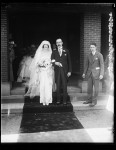 That would explain why Bonnie Revis had a sliver of the cake, because it was widely distributed to all the staff and attendants, and she was cook from 1924 to 1935 (coincidentally almost exactly the duration of the Vanderbilt-Cecil marriage). Cornelia’s late father George Vanderbilt (grandson of railroad magnate Commodore Cornelius Vanderbilt) and her mother Edith Stuyvesant Dresser were deeply involved in the Asheville community and employed hundreds of people at the estate. When Cornelia, only child of George and Edith, married the Honorable John Francis Amherst Cecil, third son of Lord Cecil and the Baroness Amherst of Hackney, direct descendant of William Cecil, Lord Burghley, Queen Elizabeth I’s Lord High Treasurer, the entire town assembled outside All Souls’ Church to watch the couple and 1,000 guests arrive and depart.
That would explain why Bonnie Revis had a sliver of the cake, because it was widely distributed to all the staff and attendants, and she was cook from 1924 to 1935 (coincidentally almost exactly the duration of the Vanderbilt-Cecil marriage). Cornelia’s late father George Vanderbilt (grandson of railroad magnate Commodore Cornelius Vanderbilt) and her mother Edith Stuyvesant Dresser were deeply involved in the Asheville community and employed hundreds of people at the estate. When Cornelia, only child of George and Edith, married the Honorable John Francis Amherst Cecil, third son of Lord Cecil and the Baroness Amherst of Hackney, direct descendant of William Cecil, Lord Burghley, Queen Elizabeth I’s Lord High Treasurer, the entire town assembled outside All Souls’ Church to watch the couple and 1,000 guests arrive and depart.
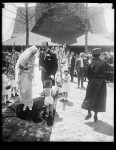 Many workers at the Biltmore Estate were guests or actually part of the wedding. When the newlyweds left the church arm in arm after the ceremony, they and the wedding party walked through an arch of crossed flowering branches held by 44 children of Biltmore Estate staff. The youngest, Polly Ann Flower, greeted them at the end of the arch wearing a little white Cupid outfit.
Many workers at the Biltmore Estate were guests or actually part of the wedding. When the newlyweds left the church arm in arm after the ceremony, they and the wedding party walked through an arch of crossed flowering branches held by 44 children of Biltmore Estate staff. The youngest, Polly Ann Flower, greeted them at the end of the arch wearing a little white Cupid outfit.
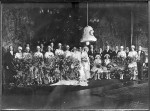 There are no records surviving of what kind of wedding cake was served, but fruitcake was traditionally the groom’s cake, so it’s like this sliver was carved off John Cecil’s cake rather than whatever massive confection served as the primary wedding cake. It was made by Rauscher’s, identified by a stamp inside the bottom of the box, a bakery in Washington, D.C. George and Edith had a home on K Street in D.C., and Cornelia was staying there when she met Cecil. He was ten years older than her and an accomplished diplomat. When they met in 1923, he was the first secretary at the British Embassy and part of a group of highly eligible men known in D.C. society as the “British Bachelors.” Cornelia and John hit it off right away, announcing their engagement just a few months after they met.
There are no records surviving of what kind of wedding cake was served, but fruitcake was traditionally the groom’s cake, so it’s like this sliver was carved off John Cecil’s cake rather than whatever massive confection served as the primary wedding cake. It was made by Rauscher’s, identified by a stamp inside the bottom of the box, a bakery in Washington, D.C. George and Edith had a home on K Street in D.C., and Cornelia was staying there when she met Cecil. He was ten years older than her and an accomplished diplomat. When they met in 1923, he was the first secretary at the British Embassy and part of a group of highly eligible men known in D.C. society as the “British Bachelors.” Cornelia and John hit it off right away, announcing their engagement just a few months after they met.
 John Cecil resigned his position before the wedding, choosing instead to focus on the management of the Biltmore Estate. It became his life-long vocation. He continued to live at and manage Biltmore until his death in 1954, twenty years after his divorce from Cornelia. She, on the other hand, got married to an English banker in 1949 and moved to England where she spent the rest of her life. John and Cornelia’s sons took over management of the estate after John’s death, George Henry Vanderbilt Cecil running Biltmore Farms (the successful dairy farm branch), his younger brother William Amherst Vanderbilt Cecil taking on the Biltmore Estate, including the house and vinyards he planted. Their children manage the estate today.
John Cecil resigned his position before the wedding, choosing instead to focus on the management of the Biltmore Estate. It became his life-long vocation. He continued to live at and manage Biltmore until his death in 1954, twenty years after his divorce from Cornelia. She, on the other hand, got married to an English banker in 1949 and moved to England where she spent the rest of her life. John and Cornelia’s sons took over management of the estate after John’s death, George Henry Vanderbilt Cecil running Biltmore Farms (the successful dairy farm branch), his younger brother William Amherst Vanderbilt Cecil taking on the Biltmore Estate, including the house and vinyards he planted. Their children manage the estate today.
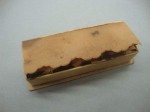 As for the piece of cake, it is now in the freezer, for historical rather than culinary preservation purposes. It is still inside its original gift box, protected by several nested Ziploc bags.
As for the piece of cake, it is now in the freezer, for historical rather than culinary preservation purposes. It is still inside its original gift box, protected by several nested Ziploc bags.